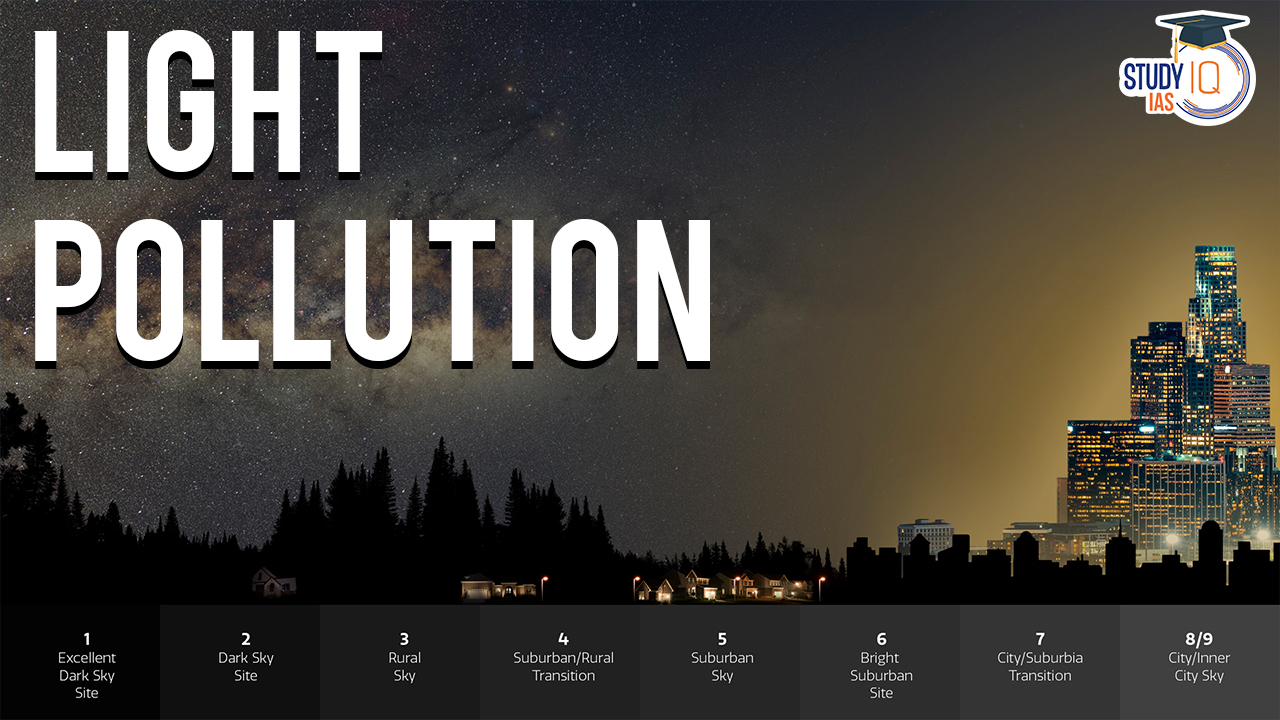Table of Contents
Context: Researchers have documented the impact of light pollution on ecosystems, human health, and culture.
Key Observations
- Light Pollution impacts the environment and causes habitat loss, disruption of food webs, and declining insect populations and is responsible for substantial greenhouse gas emissions.
- Artificial light at night has variable and complex impacts on plants, animals, and entire ecosystems.
- Some species respond to light pollution, making it difficult to mitigate the negative impacts of light across an ecosystem.
What is Light Pollution?
- Light pollution refers to the excessive or misdirected artificial lighting that causes adverse effects on the environment, human health, and our ability to observe the night sky.
- It occurs when artificial light is used inappropriately or inefficiently, leading to the excessive illumination of the nighttime environment.
- It’s a side effect of industrial civilization and urbanization.
- Its sources include building exterior and interior lighting, advertising, outdoor area lighting (such as car parks), offices, factories, streetlights and illuminated sporting venues.

Types of Light Pollution

Stats IQ: Light pollution across the globe and India
- According to the World Atlas on Night Sky Brightness:
- More than 80% of the world’s population lives under light-polluted skies, meaning that the night sky is obscured by artificial light.
- Nearly one-third of the global population cannot see the Milky Way due to light pollution.
- Moreover, 23% of the world’s land surfaces between 75°N and 60°S, 88% of Europe, and almost half of the United States experience light-polluted nights.
- According to a study “Artificial night sky brightness and its impact on human health and environment in India” published in 2019, the brightness of India’s night skies has increased by around 20% over the past decade.
- The above study also found that around 70% of India’s population lives under light-polluted skies, and the problem is particularly acute in major cities like Mumbai, New Delhi, and Kolkata.
Impacts of Light Pollution
- Human health: An increased amount of light at night lowers melatonin production, which results in sleep deprivation, fatigue, headaches, stress, anxiety, and other health problems.
- Environmental impacts:
- Impact on nocturnal wildlife: Light pollution radically alters the nighttime environment by turning night into day, which will have negative impact on physiology, breeding patterns and mating behaviors of nocturnal animals.
- Disrupting ecosystems: Artificial light can disrupt the natural rhythms of wildlife, such as birds, insects, and sea turtles. This can make it difficult for them to navigate, feed, and reproduce, which can have a ripple effect on entire ecosystems.
- Disturbing migratory patterns: Birds, butterflies, and other animals rely on the stars and moonlight to navigate during migration. Artificial light can disorient and confuse these animals, making it difficult for them to reach their destination.
- Insect biodiversity loss: Artificial light alters the patterns of insect movement, foraging, reproduction and predation of insects resulting in the decline of insect population.
- Greenhouse Gas Emissions: The energy consumed for lighting contributes to greenhouse gas emissions. It is estimated that light pollution produces around 12 million metric tons of carbon dioxide (CO2) emissions annually.
- Economic impacts: Light pollution can have a significant impact on the economy by reducing visibility, hindering astronomical research, and diminishing the value of dark skies for tourism and recreation.
- Impacts on astronomical observations: Light pollution is one of the main factors that affect astronomical observations, which makes it difficult to see celestial objects from the ground.
- Energy consumption: Light pollution contributes to energy waste as much of the light is directed upwards and not towards the intended targets.
Global initiatives to curb light pollution
- The International Dark-Sky Association (IDA): The IDA is a non-profit organization that works to protect the night skies for present and future generations by advocating for responsible outdoor lighting and promoting dark sky places.
- The Globe at Night program: This program is an international citizen-science campaign to raise public awareness of the impact of light pollution.
- The World Atlas of Artificial Night Sky Brightness: This project, led by researchers, compiles and maps global data on artificial sky brightness. It helps researchers, policymakers, and the public understand the extent and distribution of light pollution.
- The International Year of Light and Light-based Technologies (IYL 2015): It was by the United Nations to raise awareness of the importance of light and optical technologies in our daily lives, and to encourage the responsible use of artificial light to reduce light pollution.
Way Forward
- Efficient Lighting Technology: Promoting the use of energy-efficient lighting technologies such as light-emitting diodes (LEDs) and ensuring that they are properly designed and shielded to minimize light pollution.
- Smart Lighting Systems: Utilizing smart lighting systems that can be programmed to adjust brightness levels based on occupancy and time of day. These systems can reduce light pollution by providing the right amount of light when and where it is needed, avoiding over-illumination.
- Outdoor Lighting Regulations: Implementing regulations to control the intensity, direction, and color temperature of outdoor lighting. This can help reduce light spillage and unnecessary upward light, focusing illumination where it is needed while minimizing light trespass and skyglow.
- Education and Awareness: Increasing the public awareness about the impacts of light pollution on the environment, human health, and astronomy is the need of the hour.
- Individual Actions: There is a need to encourage individuals to take personal responsibility by using lighting judiciously. This includes turning off unnecessary outdoor lights, using motion sensor lights or timers, and choosing energy-efficient lighting options such as LED bulbs.
- International Cooperation: Foster international cooperation and exchange of best practices to address light pollution on a global scale. Encourage countries to adopt lighting standards and regulations that prioritize dark skies and minimize light pollution.


 Question Hour in Parliament: Meaning, Ty...
Question Hour in Parliament: Meaning, Ty...
 Daily Quiz 18 July 2025
Daily Quiz 18 July 2025





















